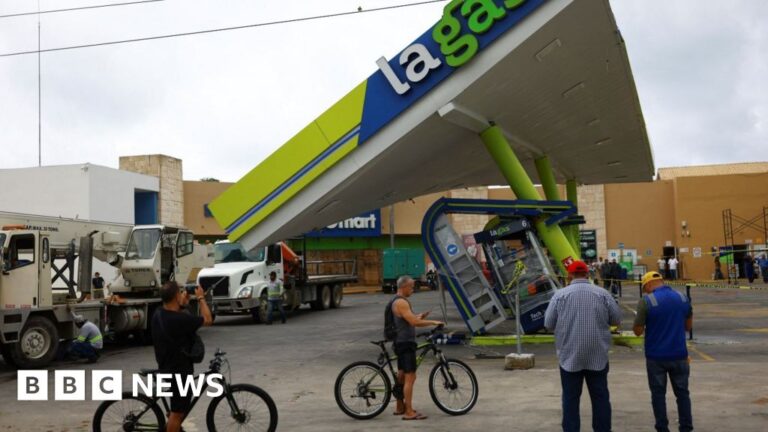- author, Ian Aikman
- role, BBC News
-
Hurricane Beryl wreaked havoc across the Caribbean before hitting Mexico’s Yucatan Peninsula, killing at least 10 people.
It made landfall early Friday as a Category 2 hurricane, with maximum sustained winds of 175 kph (108 mph).
It later weakened to a tropical storm but is expected to strengthen again over the weekend in the Gulf of Mexico.
Beryl brought heavy rain to the tourist destinations of Cancun and Tulum, and while no major damage was reported, strong winds downed trees and caused power outages.
Civil Defense chief Laura Velazquez said power supply to areas still without electricity would be fully restored by Sunday.
Tulum resident Carolina Vásquez was among those affected by the power outage and spoke to Reuters as she queued at a soup kitchen organised by the Mexican military on Friday.
“A tree fell on my little house, splitting half of the house and taking off roof tiles,” she said.
“We’re evaluating it, but so far, everything seems to be going well with the protective measures that have been put in place and the preparations that have been made,” said Fernando Trevino, an employee at a local business.
Ahead of Beryl’s arrival, schools were closed, hotel windows were boarded up and emergency shelters were set up in areas expected to be hit directly by the impact.
More than 8,000 troops from the Army, Air Force and National Guard were sent to the Yucatan Peninsula to help.
Hundreds of tourists were evacuated from hotels and more than 3,000 people fled the offshore island of Holbox, local authorities said.
More than 300 flights were canceled or delayed.
Many homes and businesses sustained extensive damage in the Cayman Islands on Thursday, with entire areas flooded, especially along the coast.
Hurricanes are common near the peninsula, with the official storm season running from June to late November.
Where will Hurricane Beryl go next?
The storm is expected to move through the Gulf of Mexico and into northeastern Mexico and southern Texas by the end of the weekend.
The storm is expected to strengthen into a hurricane again by the time it makes landfall again Sunday evening.
Texas Governor Greg Abbott urged people living along the state’s Gulf Coast to “have an emergency plan in place to protect yourself and your loved ones.”
The National Oceanic and Atmospheric Administration has warned that the North Atlantic could see up to seven major hurricanes this year, up from an average of three per season.

